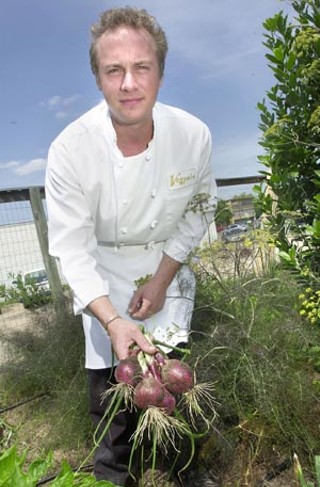How Green Was My Alley
Local restaurants grown their own
By Barbara Chisholm, Fri., May 25, 2007

It's difficult to say whether the inspiration was Alice Waters or Texas pioneers, but some homegrown Austin restaurants make a point of establishing the connection between the farm field and the plate. For these businesses, the source of the produce is on equal footing with the finished, prepared product. Keeping green in the restaurant world isn't necessarily about being vegetarian; it's about knowing your farmer, even if that farmer is in the mirror.
When Dorsey Barger of Eastside Cafe comes to work, she dons a manager's hat and a farmer's cap, at least figuratively. For 19 years, Eastside has had a one-third-acre garden on-site that provides herbs, garnishes, flowers, tomatoes, lettuces, squash, and more. The garden was part of Eastside from its inception, and though small in size, its contributions are enormous. "During peak season, we get all our tomatoes for the restaurant from the garden. In cooler months, we'll have lots of romaine and feature Caesar salad for weeks and weeks," Barger reports. Every plate from the kitchen is garnished with fresh flowers and/or herbs, all of which come from the garden.
Barger's enthusiasm for the garden is such that she and Elaine Martin, chef and overseer of the garden, and David Kolosta, their gardening guru, were brainstorming about ways to increase customers' awareness of and appreciation for grow-your-own meals. As tillers of the field, they recognize that Texas weather can make gardening a sticky proposition, so they inaugurated monthly indoor gardening workshops plus a thematic meal, complete with wine pairings, that occurs in the garden shop. Topics are garden-driven; it might be a class on planting hot peppers that can withstand even Texas summers and include a dinner of spicy pepper dishes and German Riesling wines that go with them. Another month might have a class on potatoes that features a meal of the cafe's potato-leek soup among other things and the Pinot Noir wines to drink with the menu.
Although the garden's limitations require considerable augmenting of produce from conventional sources, Eastside is green in other operations, too. Kitchen (not customer) scraps are composted, creating organic fertilizer that feeds the garden, and everything in the restaurant that can be recycled is recycled, from bottles to plastic to metal. For homeowners with curbside recycling, this might not sound like much of a feat, but for a commercial venture where recycling sources must be obtained on your own and the drop-off of recyclables factored into the workweek, the achievement is significant.
Farther south, Vespaio owner and chef Alan Lazarus took advantage of a patch of adjoining land acquired a few years after the opening of the wildly popular South Congress restaurant and decided to create a garden. The tending of the garden has become part of the shift at the restaurant with chef de cuisine Ryan Samson assuming leadership. Year-round the small but prolific garden includes herbs, melons, squash, cucumbers, and peppers that find their way to the kitchen and onto the menu. An Italian restaurant requires considerable tomatoes, and as the first harvest should happen soon, devoted diners are already anticipating the unparalleled simple goodness of a caprese salad created with just-picked basil and tomatoes.
Kerbey Lane Cafe, an Austin institution for more than 25 years, partners with farmers Cora and Bobby Lamar to provide farm freshness to their tables. It began with the search for some luscious tomatoes, which can be akin to searching for the Holy Grail when commercial sources are the only option. Owners David Ayer and Patricia Atkinson struck a deal with the Lamars to provide tomatoes to the cafes for a season. Once the Lamar's tomatoes appeared on the menu, there was no going back. Today, the Lamar farm supplies a variety of the fruits and veggies that appear at Kerbey Lane's four restaurants. Twice weekly, farm deliveries are made, and the greens, squash, beans, broccoli, and herbs find their way to diners' plates. Additional produce is obtained from Boggy Creek Farm and local farmers' market vendors. Between the Lamars and other local providers, Kerbey Lane obtains about 70% of its produce locally.
The enthusiasm for fresh and local goods has become part of Kerbey's identity, and today much of its nonproduce items are often local, as well. Eggs, bacon, chicken, honey, and tofu all come from local suppliers such as Food You Can Trust, East Poultry, Buddy's, Good Flow, and White Mountain. Manager Jeff Leeper explains that not only do these suppliers provide the freshest food possible, "They develop the local economy and a green system," both of which are important priorities for Kerbey Lane.
"We try to do the right thing," Emmett Fox of Asti and Fino explains of his restaurants' use of local produce. The right thing, as Fox sees it, includes getting as much produce as local as he can. To this end, he regularly patronizes Boggy Creek, the in-town organic farm with an awesome array of vegetables. The early summer stuff is in (or up or out), and at Boggy Creek that means squash, blackberries, potatoes, cucumbers, artichokes, green beans, onions, chard, kale, and herbs. So plentiful is Boggy Creek's bounty and so voracious are the customers of Asti and Fino for the fresh stuff that they shop twice a week at the farm.
But still, it isn't enough, so the Foxes (Lisa, Emmett's wife, is his partner in life and food) have developed a relationship with farmer Harley Clark of Dripping Springs, who grows exclusively for the duo's dual restaurants. The partnership is in its fourth year, and, like the products it yields, it's a growing one. Each season, the chefs from Fino and Asti and the Foxes sit down with Clark and discuss the upcoming crop: what they like and which new varieties they'd like to try. Recently, Fox brought some pepper seeds he acquired on a recent trip to Spain to Clark to see if he could make a go of them in the upcoming hot months.
"I think it's important to do it that way," Fox says. "The staff goes out to the farm to see it, how close it is, and the reality of it."








